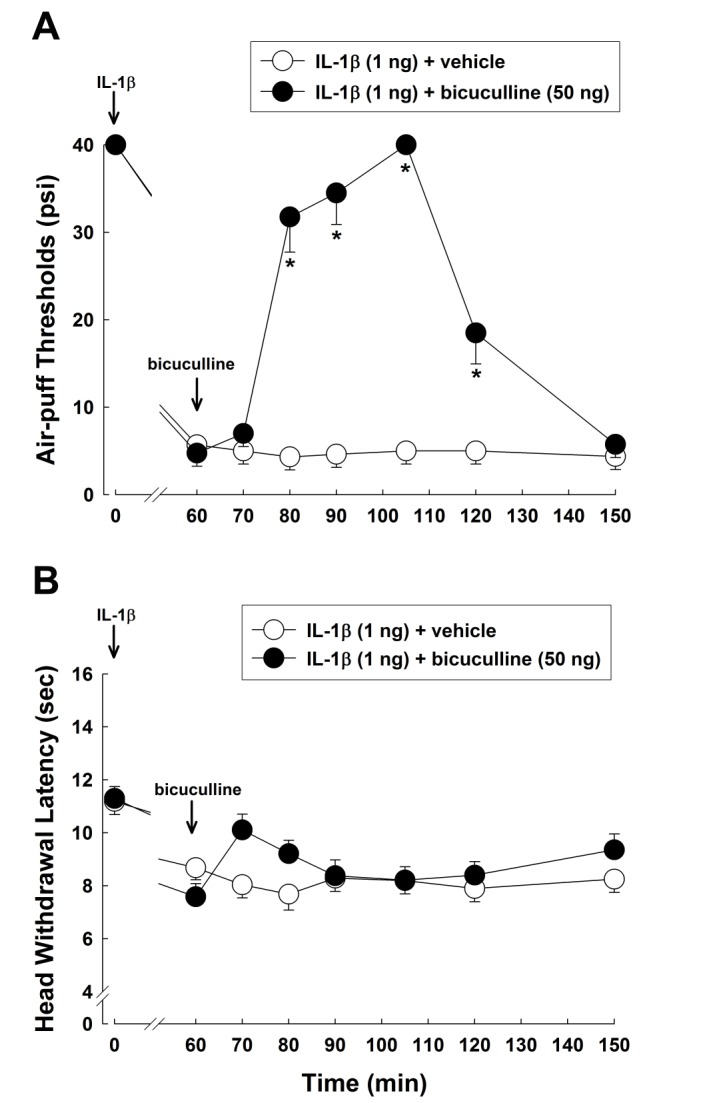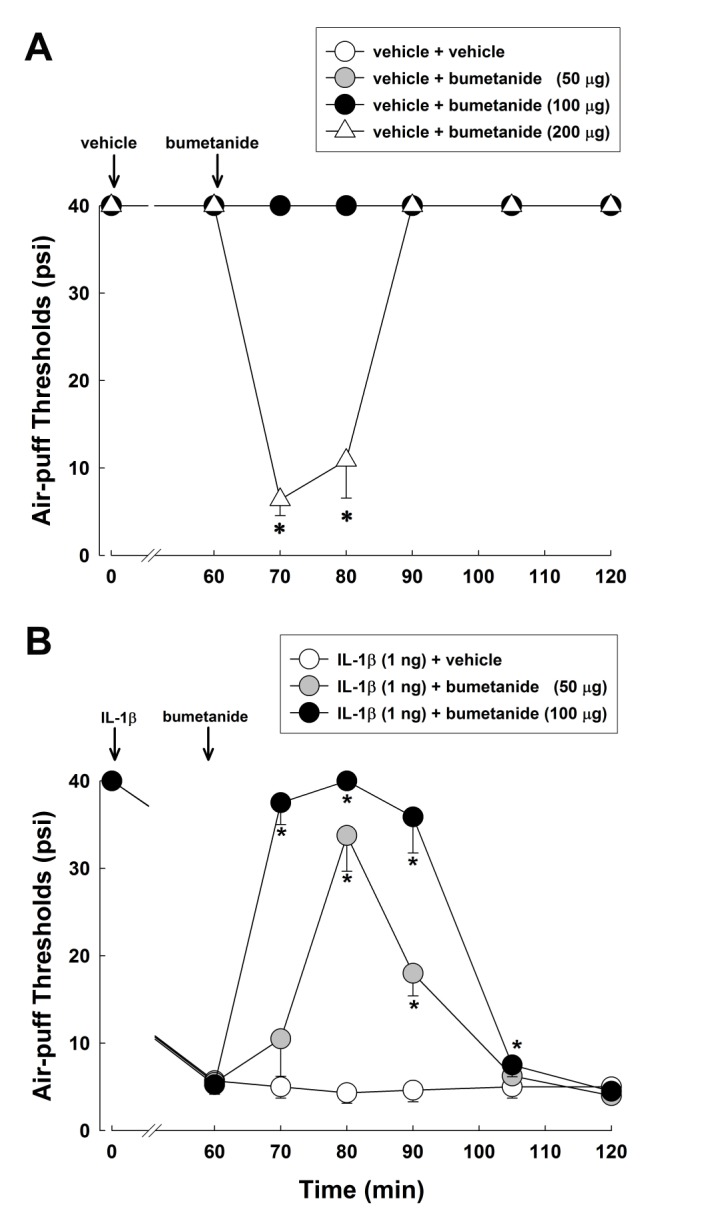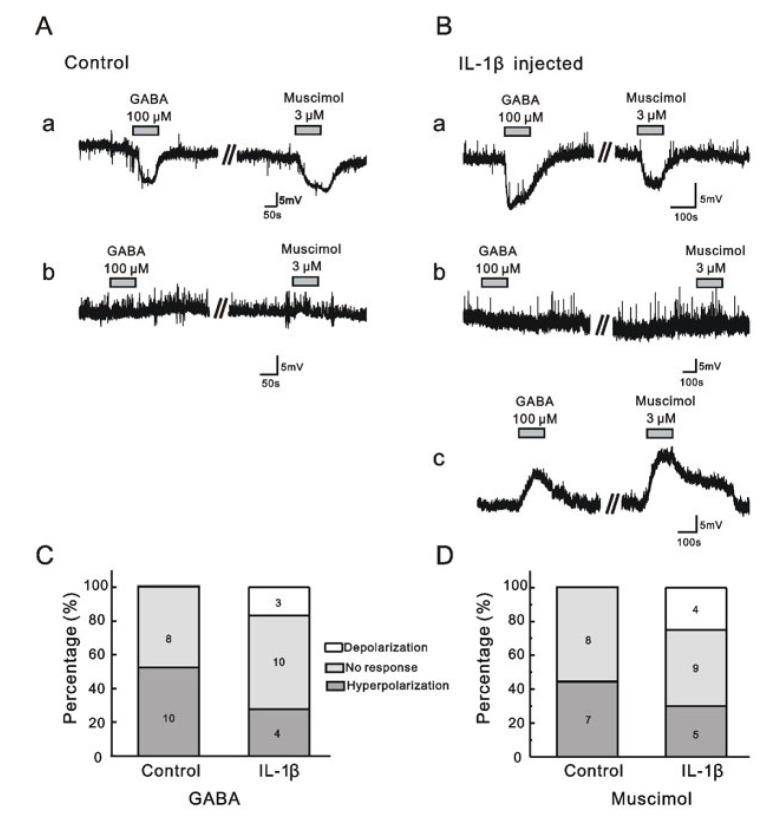Korean J Physiol Pharmacol.
2017 Jan;21(1):65-74. 10.4196/kjpp.2017.21.1.65.
Participation of central GABAA receptors in the trigeminal processing of mechanical allodynia in rats
- Affiliations
-
- 1Department of Oral Physiology, School of Dentistry, Kyungpook National University, Daegu 41940, Korea. dkahn@knu.ac.kr
- 2Department of Oral Anatomy, School of Dentistry, Kyungpook National University, Daegu 41940, Korea.
- 3Department of Oral Physiology, School of Dentistry and Institute of Oral Bioscience, Chonbuk National University, Jeonju 54896, Korea. skhan@jbnu.ac.kr
- KMID: 2371069
- DOI: http://doi.org/10.4196/kjpp.2017.21.1.65
Abstract
- Here we investigated the central processing mechanisms of mechanical allodynia and found a direct excitatory link with low-threshold input to nociceptive neurons. Experiments were performed on male Sprague-Dawley rats weighing 230-280 g. Subcutaneous injection of interleukin 1 beta (IL-1β) (1 ng/10 µL) was used to produce mechanical allodynia and thermal hyperalgesia. Intracisternal administration of bicuculline, a gamma aminobutyric acid A (GABAA) receptor antagonist, produced mechanical allodynia in the orofacial area under normal conditions. However, intracisternal administration of bicuculline (50 ng) produced a paradoxical anti-allodynic effect under inflammatory pain conditions. Pretreatment with resiniferatoxin (RTX), which depletes capsaicin receptor protein in primary afferent fibers, did not alter the paradoxical anti-allodynic effects produced by the intracisternal injection of bicuculline. Intracisternal injection of bumetanide, an Na-K-Cl cotransporter (NKCC 1) inhibitor, reversed the IL-1β-induced mechanical allodynia. In the control group, application of GABA (100 µM) or muscimol (3 µM) led to membrane hyperpolarization in gramicidin perforated current clamp mode. However, in some neurons, application of GABA or muscimol led to membrane depolarization in the IL-1β-treated rats. These results suggest that some large myelinated Aβ fibers gain access to the nociceptive system and elicit pain sensation via GABA(A) receptors under inflammatory pain conditions.
MeSH Terms
-
Animals
Bicuculline
Bumetanide
Capsaicin
gamma-Aminobutyric Acid
Gramicidin
Humans
Hyperalgesia*
Injections, Subcutaneous
Interleukin-1beta
Male
Membranes
Muscimol
Myelin Sheath
Neurons
Nociceptors
Rats*
Rats, Sprague-Dawley
Receptors, GABA-A
Sensation
Bicuculline
Bumetanide
Capsaicin
Gramicidin
Interleukin-1beta
Muscimol
Receptors, GABA-A
gamma-Aminobutyric Acid
Figure
Cited by 1 articles
-
The antinociceptive effect of artemisinin on the inflammatory pain and role of GABAergic and opioidergic systems
Faraz Mahdian Dehkordi, Jahangir Kaboutari, Morteza Zendehdel, Moosa Javdani
Korean J Pain. 2019;32(3):160-167. doi: 10.3344/kjp.2019.32.3.160.
Reference
-
1. Merskey H, Bogduk N. Classification of chronic pain. Seattle: IASP Press;1994.2. Campbell JN, Raja SN, Meyer RA, Mackinnon SE. Myelinated afferents signal the hyperalgesia associated with nerve injury. Pain. 1988; 32:89–94. PMID: 3340426.
Article3. Gracely RH, Lynch SA, Bennett GJ. Painful neuropathy: altered central processing maintained dynamically by peripheral input. Pain. 1992; 51:175–194. PMID: 1484715.
Article4. Kim MJ, Lee SY, Yang KY, Nam SH, Kim HJ, Kim YJ, Bae YC, Ahn DK. Differential regulation of peripheral IL-1β-induced mechanical allodynia and thermal hyperalgesia in rats. Pain. 2014; 155:723–732. PMID: 24406203.
Article5. Xu ZZ, Kim YH, Bang S, Zhang Y, Berta T, Wang F, Oh SB, Ji RR. Inhibition of mechanical allodynia in neuropathic pain by TLR5-mediated A-fiber blockade. Nat Med. 2015; 21:1326–1331. PMID: 26479925.
Article6. Price TJ, Cervero F, de Koninck Y. Role of cation-chloride-cotransporters (CCC) in pain and hyperalgesia. Curr Top Med Chem. 2005; 5:547–555. PMID: 16022677.7. Sandkühler J. Models and mechanisms of hyperalgesia and allodynia. Physiol Rev. 2009; 89:707–758. PMID: 19342617.
Article8. Jung CY, Choi HS, Ju JS, Park HS, Kwon TG, Bae YC, Ahn DK. Central metabotropic glutamate receptors differentially participate in interleukin-1beta-induced mechanical allodynia in the orofacial area of conscious rats. J Pain. 2006; 7:747–756. PMID: 17018335.9. Jung CY, Lee SY, Choi HS, Lim EJ, Lee MK, Yang GY, Han SR, Youn DH, Ahn DK. Participation of peripheral group I and II metabotropic glutamate receptors in the development or maintenance of IL-1beta-induced mechanical allodynia in the orofacial area of conscious rats. Neurosci Lett. 2006; 409:173–178. PMID: 17030435.10. Yaksh TL, Rudy TA. Chronic catheterization of the spinal subarachnoid space. Physiol Behav. 1976; 17:1031–1036. PMID: 14677603.
Article11. Kim HJ, Lee GW, Kim MJ, Yang KY, Kim ST, Bae YC, Ahn DK. Antinociceptive effects of transcytosed botulinum neurotoxin type A on trigeminal nociception in rats. Korean J Physiol Pharmacol. 2015; 19:349–355. PMID: 26170739.
Article12. Yang GY, Lee MK, Bae YC, Ahn DK. Intracisternal administration of COX inhibitors attenuates mechanical allodynia following compression of the trigeminal ganglion in rats. Prog Neuropsychopharmacol Biol Psychiatry. 2009; 33:589–595. PMID: 19239920.
Article13. Yang KY, Mun JH, Park KD, Kim MJ, Ju JS, Kim ST, Bae YC, Ahn DK. Blockade of spinal glutamate recycling produces paradoxical antinociception in rats with orofacial inflammatory pain. Prog Neuropsychopharmacol Biol Psychiatry. 2015; 57:100–109. PMID: 25445477.
Article14. Jeon HJ, Han SR, Lim KH, Won KA, Bae YC, Ahn DK. Intracisternal administration of NR2 subunit antagonists attenuates the nociceptive behavior and p-p38 MAPK expression produced by compression of the trigeminal nerve root. Mol Pain. 2011; 7:46. PMID: 21651766.
Article15. Won KA, Kim MJ, Yang KY, Park JS, Lee MK, Park MK, Bae YC, Ahn DK. The glial-neuronal GRK2 pathway participates in the development of trigeminal neuropathic pain in rats. J Pain. 2014; 15:250–261. PMID: 24216329.
Article16. Ahn DK, Lee SY, Han SR, Ju JS, Yang GY, Lee MK, Youn DH, Bae YC. Intratrigeminal ganglionic injection of LPA causes neuropathic pain-like behavior and demyelination in rats. Pain. 2009; 146:114–120. PMID: 19665300.
Article17. Ahn DK, Lim EJ, Kim BC, Yang GY, Lee MK, Ju JS, Han SR, Bae YC. Compression of the trigeminal ganglion produces prolonged nociceptive behavior in rats. Eur J Pain. 2009; 13:568–575. PMID: 18774318.
Article18. Lee MK, Shin HJ, Yang GY, Yoon YW, Han SK, Bae YC, Ahn DK. Intracisternal and intraperitoneal administration of morphine attenuates mechanical allodynia following compression of the trigeminal ganglion in rats. J Orofac Pain. 2010; 24:113–121. PMID: 20213037.19. Yang KY, Kim MJ, Ju JS, Park SK, Lee CG, Kim ST, Bae YC, Ahn DK. Antinociceptive effects of botulinum toxin type A on trigeminal neuropathic pain. J Dent Res. 2016; 95:1183–1190. PMID: 27418174.
Article20. Han SR, Yang GY, Ahn MH, Kim MJ, Ju JS, Bae YC, Ahn DK. Blockade of microglial activation reduces mechanical allodynia in rats with compression of the trigeminal ganglion. Prog Neuropsychopharmacol Biol Psychiatry. 2012; 36:52–59. PMID: 22019843.
Article21. Jeon HJ, Han SR, Park MK, Yang KY, Bae YC, Ahn DK. A novel trigeminal neuropathic pain model: compression of the trigeminal nerve root produces prolonged nociception in rats. Prog Neuropsychopharmacol Biol Psychiatry. 2012; 38:149–158. PMID: 22449477.
Article22. Kim MJ, Shin HJ, Won KA, Yang KY, Ju JS, Park YY, Park JS, Bae YC, Ahn DK. Progesterone produces antinociceptive and neuroprotective effects in rats with microinjected lysophosphatidic acid in the trigeminal nerve root. Mol Pain. 2012; 8:16. PMID: 22429647.
Article23. Park CK, Kim K, Jung SJ, Kim MJ, Ahn DK, Hong SD, Kim JS, Oh SB. Molecular mechanism for local anesthetic action of eugenol in the rat trigeminal system. Pain. 2009; 144:84–94. PMID: 19376653.
Article24. Khan GM, Chen SR, Pan HL. Role of primary afferent nerves in allodynia caused by diabetic neuropathy in rats. Neuroscience. 2002; 114:291–299. PMID: 12204199.
Article25. Pan HL, Khan GM, Alloway KD, Chen SR. Resiniferatoxin induces paradoxical changes in thermal and mechanical sensitivities in rats: mechanism of action. J Neurosci. 2003; 23:2911–2919. PMID: 12684478.
Article26. Kim YH, Back SK, Davies AJ, Jeong H, Jo HJ, Chung G, Na HS, Bae YC, Kim SJ, Kim JS, Jung SJ, Oh SB. TRPV1 in GABAergic interneurons mediates neuropathic mechanical allodynia and disinhibition of the nociceptive circuitry in the spinal cord. Neuron. 2012; 74:640–647. PMID: 22632722.
Article27. Bhattarai JP, Park SA, Park JB, Lee SY, Herbison AE, Ryu PD, Han SK. Tonic extrasynaptic GABA(A) receptor currents control gonadotropin-releasing hormone neuron excitability in the mouse. Endocrinology. 2011; 152:1551–1561. PMID: 21285326.
Article28. Yaksh TL. Behavioral and autonomic correlates of the tactile evoked allodynia produced by spinal glycine inhibition: effects of modulatory receptor systems and excitatory amino acid antagonists. Pain. 1989; 37:111–123. PMID: 2542867.
Article29. Ishikawa T, Marsala M, Sakabe T, Yaksh TL. Characterization of spinal amino acid release and touch-evoked allodynia produced by spinal glycine or GABA(A) receptor antagonist. Neuroscience. 2000; 95:781–786. PMID: 10670445.
Article30. Baba H, Doubell TP, Woolf CJ. Peripheral inflammation facilitates Abeta fiber-mediated synaptic input to the substantia gelatinosa of the adult rat spinal cord. J Neurosci. 1999; 19:859–867. PMID: 9880605.31. Castro-Lopes JM, Tavares I, Tölle TR, Coito A, Coimbra A. Increase in GABAergic cells and GABA levels in the spinal cord in unilateral inflammation of the Hindlimb in the rat. Eur J Neurosci. 1992; 4:296–301. PMID: 12106356.
Article32. Castro-Lopes JM, Tavares I, Tölle TR, Coimbra A. Carrageenan-induced inflammation of the hind foot provokes a rise of GABA-immunoreactive cells in the rat spinal cord that is prevented by peripheral neurectomy or neonatal capsaicin treatment. Pain. 1994; 56:193–201. PMID: 8008409.
Article33. Baba H, Ji RR, Kohno T, Moore KA, Ataka T, Wakai A, Okamoto M, Woolf CJ. Removal of GABAergic inhibition facilitates polysynaptic A fiber-mediated excitatory transmission to the superficial spinal dorsal horn. Mol Cell Neurosci. 2003; 24:818–830. PMID: 14664828.
Article34. Payne JA. Functional characterization of the neuronal-specific K-Cl cotransporter: implications for [K+] regulation. Am J Physiol. 1997; 273:C1516–C1525. PMID: 9374636.35. Payne JA, Rivera C, Voipio J, Kaila K. Cation-chloride co-transporters in neuronal communication, development and trauma. Trends Neurosci. 2003; 26:199–206. PMID: 12689771.
Article36. Morales-Aza BM, Chillingworth NL, Payne JA, Donaldson LF. Inflammation alters cation chloride cotransporter expression in sensory neurons. Neurobiol Dis. 2004; 17:62–69. PMID: 15350966.
Article37. Galan A, Cervero F. Painful stimuli induce in vivo phosphorylation and membrane mobilization of mouse spinal cord NKCC1 co-transporter. Neuroscience. 2005; 133:245–252. PMID: 15893647.
Article38. Pitcher MH, Price TJ, Entrena JM, Cervero F. Spinal NKCC1 blockade inhibits TRPV1-dependent referred allodynia. Mol Pain. 2007; 3:17. PMID: 17603899.
Article39. Granados-Soto V, Arguelles CF, Alvarez-Leefmans FJ. Peripheral and central antinociceptive action of Na+-K+-2Cl- cotransporter blockers on formalin-induced nociception in rats. Pain. 2005; 114:231–238. PMID: 15733649.40. Coull JA, Boudreau D, Bachand K, Prescott SA, Nault F, Sík A, De Koninck P, De Koninck Y. Trans-synaptic shift in anion gradient in spinal lamina I neurons as a mechanism of neuropathic pain. Nature. 2003; 424:938–942. PMID: 12931188.
Article41. Miletic G, Miletic V. Loose ligation of the sciatic nerve is associated with TrkB receptor-dependent decreases in KCC2 protein levels in the ipsilateral spinal dorsal horn. Pain. 2008; 137:532–539. PMID: 18063479.
Article42. Nomura H, Sakai A, Nagano M, Umino M, Suzuki H. Expression changes of cation chloride cotransporters in the rat spinal cord following intraplantar formalin. Neurosci Res. 2006; 56:435–440. PMID: 17007947.
Article
- Full Text Links
- Actions
-
Cited
- CITED
-
- Close
- Share
- Similar articles
-
- Participation of D-serine and NR2 subunits in EphA4-mediated trigeminal neuropathic pain
- Differential Role of Central GABA Receptors in Nociception of Orofacial Area in Rats
- Animal Models for Orofacial Neuropathic Pain
- The Intracisternal Administration of MEK Inhibitor Attenuates Mechanical and Cold Allodynia in a Rat Model of Compression of the Trigeminal Ganglion
- Preemptive application of QX-314 attenuates trigeminal neuropathic mechanical allodynia in rats






